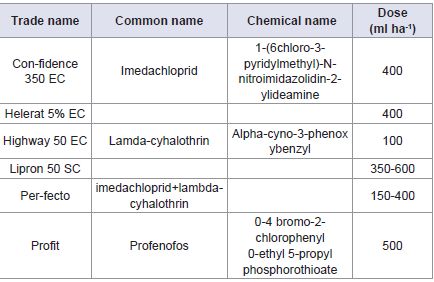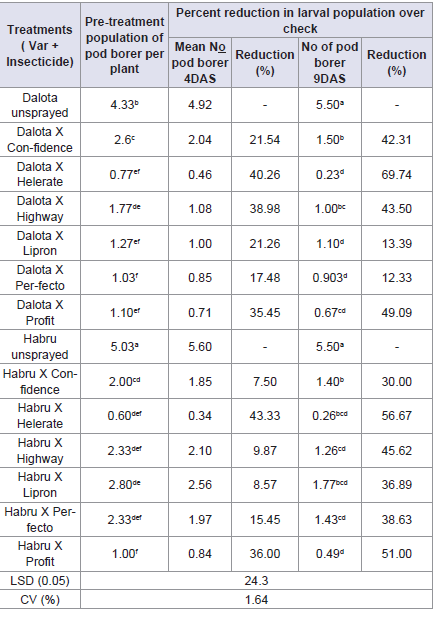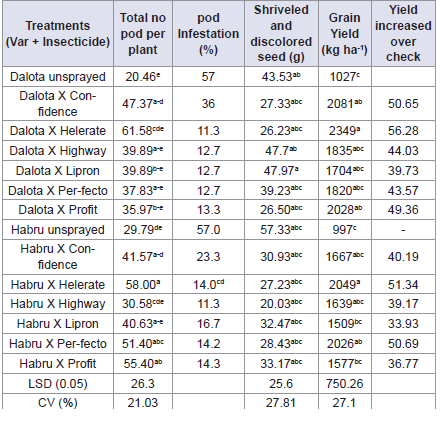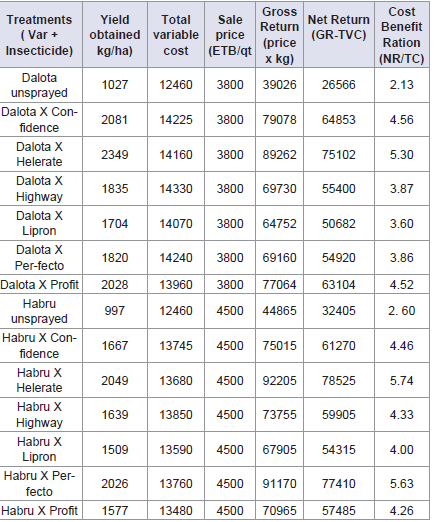Journal of Plant Biology & Soil Health
Download PDF
Research Article
Integration of Insecticides and Varieties on management of Pod Borer (Helicoverpaarmigera) and productivity of Chickpea (Cicerarietinum L.) in Adola, Southern Oromia
Deresa Shumi*, Belachew Debelo, Tekalign Afeta and Rehoboth Nuguse
Bore Agricultural Research Center, Ethiopia
Address for Correspondence: Deresa Shumi, Researcher I (Agronomist), Bore Agricultural
Research Center, (BoARC) E-mail: deresashumi@gmail.com Tel: +251967474392
Submission: 04 October, 2023
Accepted: 22 December, 2023
Published: 26 December, 2023
Copyright: © 2023 Shumi D, et al. This is an open-access article distributed under the Creative Commons Attribution License, which permits unrestricted use, distribution, and reproduction in any medium, provided the original work is properly cited.
Keywords: Chickpea; Pod Borer; Helicoverpaarmigera; Insecticide;
Net Return
Abstract
Chickpea (Cicerarietinum L.) is the world’s second most important
grain legumes after common bean (Phaseolus vulgaris L.) among
food legumes grown for production worldwide. Field experiment to
evaluate and select the efficacy of insecticides for effective foliar
spray against the pod borer in chickpea crop under field conditions.
The experiment was conducted using two chickpea varieties; Dalota
and Habru with six insecticides (Helerat 5% E.C at 400 ml/ha, Profit 72%
E.C at 500 ml/ha, Perfecto 175 SC at 150-400 ml/ha, Con-fidence 35%
at 250 ml/ha, Lipron 50 SC at 600 ml/ha and Highway 50 EC at 250 ml/
ha). The result revealed that Helerat was the most effective against
pod borer on percent larval reductions. Helerate, Profit and Highway
are more effective and reduced H. armigera larvae population by
56.67%, 51% and 45.62% on Habru variety respectively.Helerat resulted
maximum seed yield 2349kg/ha and 2049 kg/ha for Dalota and Habru,
respectively. The plot sprayed with Helerat gave the maximum net
return birr 75102/ha and 78,525/ha for Dalota and Habru, respectively.
Therefore, production of chickpea with the application of Helerate was
most profit for economical production compared to other insecticides
and recommended for the study area
Introduction
Chickpea (Cicerarietinum L.) is a legume crop of the Fabaceae
family originated in present day South Eastern Turkey and adjoining
Syria (Sexena and Singh, 1987). It is the second most important
food legume in the world after common bean. The major chickpea producing
countries are India (67.41%), Australia (6.21%), Pakistan
(5.73%), Turkey (3.86%), and Myanmar (3.74%) (FAOSTAT 2015)
[1]. Ethiopia is considered as secondary center of genetic diversity for
chickpea and the wild relative of cultivated chickpea (C. arietinum L.),
is found in Tigray region (Yadeta and Geletu, 2002; Dagne et al., 2018)
[2, 3]. In Ethiopia the area coverage and the volume of production
of chickpea in 2018/2019 are 242703.73 ha and 4994255.5 quintal
with average productivity of 2.05 ton/ha. It contributes 15.18% of
Ethiopia’s total pulse production and is second after fababeans (CSA,
2018/2019). It has the ability to grow on residual moisture which
gives farmers the opportunity to engage in double cropping, since
chickpea is sown at the end of rainy season.
Chickpea (CicerarietinumL.) is the second most important cool
season food legume crop after common bean (Phaseolus vulgaris L.)
followed by field pea (Pisumsativum) and third in production among
the food legumes grown worldwide (Diapari et al., 2014; Benzohra et
al., 2014). The average chickpea yield in Ethiopia on farmers’ field is
usually below 20 q/ha although it’s potential yield is more than 50 q/
ha (Ejeta and Hussein, 2015; Melese, 2005; Zewdie, 2018b). A number
of biotic and abiotic factors are responsible for high yield gaps. This
resulted from susceptibility of chickpea landraces to frost, drought,
water-logging, poor cultural practices and low or no protection
against weeds, diseases and insect pests (Iqbal et al., 2014) [4].
Although more than 70 pathogens have been reported on chickpea
from different parts of world
However, the production of chickpea is challenging because of
different insect pests and diseases such as pod borers, cut worms,
aphids, jassids, thrips, whitefly and the storage pests (bruchids)
which are the most devastating pests of chickpea in Asia, Africa,
and Australia. Among these gram pod borers H. armigera (Hubner)
(Lepidoptera: Noctuidae) is a serious obstacle and a global concern
for the production of chickpea. This pest is a cosmopolitan, multivoltine
and highly polyphagous, which attacks a number of crops
which have agricultural importance throughout the world (Dabhi
and Patel, 2007)[5]. Gram Pod borer, Helicoverpaarmigera (Hubner)
is one of the major insect pests ofchickpea and has resulted in
substantial yield loss (37-50%) and in severe cases up to 90% pod
damage (Ahmed and Awan, 2013) [6]. Single larva can damage 40
pods and selectively feeds upon growing points and reproductive
parts of the growing crop (Khan et al., 2009) [7]. The wider host range,
multiple generations, migratory behaviour, resistance against many
conventional insecticides and high fecundity makes gram pod borer
difficult to manage. These losses can be reduced by the application
of newer insecticides with different chemistry (Sreekanth, 2014 and
Das et al., 2015) [8, 9]. Fitt (1989) [10] recorded the crops of maize,
sorghum, cotton, common bean, peas, chickpeas, tomatoes, capsicum,
vicia and to a lesser extent, okras, cabbages, lettuces, strawberries,
tobacco, sunflowers, and many of the other legumes as host plants
of the pest. It can cause damage up to 100% in unprotected chickpea
fields (Tsedeke et al., 1982; Sarwar et al., 2009) [11, 12]. The chickpea
economic threshold is one pod borer larva per one meter row length
(Zahid et al., 2008).
Different management options have been practiced against pod
borer in different areas and years. Cultural practices such as inter
cropping, deep ploughing, trap crops and sowing date have been
reported to reduce the survival and damage of H. armigera(Romeis
et al., 2004). Extracts from different parts of neem tree (neem leaf,
neem oil and neem seed kernel 5%) influenced negatively both the
survival and feeding of the larva of H. armigera(Mesfin et al., 2012).
Insecticides monocrotophos 36 WC, endosulfan 35 EC, carbaryl
WP, cypermethrin 25 EC, indoxacarb 14.5 SC, Profenofos 50 EC and
coragen 20 SP showed the highest mortality of H. armigeralarvae
on chickpea (Iqbal et al., 2014) [4]. Mesfin et al. (2012) reported
synthetic insecticides have resulted in fast and effective pest control.
Keeping in view the severe attack of gram pod borer, the objective
of the present study was aimed to evaluate and select the efficacy of
insecticides for effective foliar spray against the pod borer in chickpea
crop under field conditions.
Materials and Methods
Description of the study area:
The experiment was conducted at Adola sub-site of Bore
Agricultural Research Center (BOARC), Guji Zone, Oromia Regional
State in southern Ethiopia under rain-fed conditions during the
2016 cropping season (September-December). The site (55°36’31”N,
38°58’91”E, 1721 M) is located in Adola town in Dufa ‘Kebele’ just on
the West side of the main road to Negelle town. It is located at about
463 km south from Addis Ababa, the capital city of the country.The climatic condition of the area is a humid moisture condition,
with a relatively shorter growing season. The area receives annual
rainfall of 1084 mm with a bimodal pattern extending from April to
November. The mean annual minimum and maximum temperature
is 15.93 °C and 9.89 °C, respectively. The type of the soil is red basaltic
soil (Nitisols) and Orthic Aerosols. The soil is clay in texture and
moderately acidic with pH of around 5.88.
Experimental materials, Treatments and experimental design:
Two chickpea varieties, namely: Dalota (desi type) and Habru
(Kabuli type were used. 150 Blended NPS kg ha-1 (19% N, 38% P2O5,
7% S) was used as sources of N, P and S, respectively, for the study.
The treatments were factorial combinations of six insecticide (Helerat
5% E.C at 400 ml/ha, Profit 72% E.C at 500 ml/ha, Perfecto 175 S.C
at 150-400 ml/ha, Con-fidence 35% at 250 ml/ha, Lipron50 SC at
600 ml/ha and Highway50 EC at 250 ml/ha) with and without spray
and two Chickpea varieties (Dalota and Habru) under RCBD and
replicated three times per treatment. The gross plot size was 3.0 m×2.4
m=7.2 m2. The spacing between blocks and plots was 1.5 m and 0.1 m,
respectively. Each plot had 6 rows spaced 40 cm apart. The field was
ploughed using oxen and harrowed manually to bring the soil to fine
tilth. Normal agronomic practices were adopted for all treatments.
Application of insecticide was started at the appearance of insect at
their recommended doses. Two sprays of each insecticide were made
during flowering and podding stage. Data were recorded four times
for each treatment before and after application of insecticides.Data collection:
Number of pod borer, damaged pods and total pods per plant
were collected from eight randomly selected and tagged plants in
each treatment. The yields were taken from the harvested net plot
area excluding the borders. The infestation percentage and larval
reduction was captured using the formula,Results and Discussions
Larval Population and Infestation:
Eight plants were randomly selected from each plots and
observation were recorded at 7 days intervals. The result revealed that
insecticides were effective against pod borer even if they have different
percent larval reduction. The data summarized in table 1 below
revealed that all the treatments were significantly superior to control.
The lowest number of pod borer per plant (0.6, 1.0, and 1.03) was
recorded on chickpea treated with Helerate, Profit and Perfecto at all
crop growth stage. They reduced larval population by 69.74%, 49.09 %
and 43.5%, on Dalota variety. However, Helerate, Profit and Highway
are more effective and reduced H. armigera larvaepopulation by
56.67%, 51% and 45.62% on Habru variety respectively. In agreement
with this result, Zereabruket al., (2019) [13] reported that application
of profit insecticide has reduced larval population by 54.76% in
Laelay-mychew district, Tigray region. The present results revealed
with findings by Dagne et al. (2018) [2] who reported that the highest
pod borer larval reduction (90.63%) was found in Diazenon sprayed
plot followed by Karate 5% EC (71.87%) sprayed plot. Similarly,
Khan et al. (2009) [7]. conducted a trial against gram pod borer and
to assess comparative efficacy of insecticides (thiodan 40EC, lorsban
40EC, ripcord 10EC, nurell-D (chlorpyrifos + cypermethrin 50 + 500
g/L EC) and methomyl 45 WP). Methomyl was found most effective
against the tested pest under field conditions.Efficacy of insecticides on chickpea yield and yield components:
The data presented in Table-3 reveals that all the treatments
yielded significantly higher over control. Helerate 5% E.C at 400 ml/
ha recorded significantly highest seed yield of 2349 kg/ha and 2049
kg/ha on Dalota and Habru respectively and was found statistically
at par with Con-fidence; Highway, and Per-fecto (1667, 2026 and
1639 kg/ha yield, respectively). The minimum seed yield 997kg/
ha on unsprayed plot of Dalota. Maximum percent of seed yield
(56.28%) was increased over check by Helerate on Dalota. The second
maximum percent of seed yield (51.34%) was increased over check by
Helerate on Habru. In agreement with this result, Dagne et al. (2018)
who reported that the highest seed yield 2610 kg/ha, and Maximum
percent of seed yield (68.58%) over check were found in Diazenon
sprayed plot at ginnir.The current study also showed that all insecticides were effective
to reduce the number of damaged pods per plant compared to the
untreated check. The highest number of effective pods per plant,
lower damaged pods and infestation percentage were recorded
on insecticide applied with Helerate. Thus, application of Heleate
gives the highest effective pods per plant (61.58), lower infestation
percentage (11.3%) and minimum amount of Shriveled and discolored
seed (26.23 g) with the highest seed yield (2349 kg/ha). Savita and
Pandurang (2014) [14] reported that the lowest number of surviving
population of larvae 0.70 larvae/plant, highest yield recorded 15.00 q/
ha, lower pod damage 8.10% were recorded on chickpea treated with
rynaxypyr 20 SC at 40 g/ha
Return and benefit cost ratio:
For dalota variety the result showed that Helerate sprayed plot
provided the highest gross returns (ETB89262/ha) and the lowest
gross return TB39026/ha was computed from untreated check. The
plot sprayed with Helerate gave the maximum net return ETB 75102/
ha and gave the highest benefit cost ratio of (5.3). The unsprayed plot
gave the minimum net returns birr 26566/ha and gave the lowest
benefit cost ratio (2.31).In other way, Helerate sprayed plot with Habru variety provided
the highest gross returns (92205/ha) and the lowest gross return ETB
44865/ha was computed from untreated check. The plots prayed
with Helerate gave the maximum net return ETB 78525/ha and also
gave the highest benefit cost ratio (5.74). The unsprayed plot gave the
minimum net returns ETB 324055/ha and gave the lowest benefit cost
ratio (2. 60).
Therefore, production of chickpea with the application of
Helerate was most profit for economical production compared to
other insecticides.
Conclusions and Recommendation
The result revealed that Helerat was the most effective insecticide
to give high mortality of pod borer on chickpea under field conditions.
The most economic benefit for pod borer management was also
obtained from Helerat sprayed plot and followed by Per-fecto sprayed
plots. It has been indicated from the present studies revealed that
insecticide Helerate was most effective and economic for controlling
gram pod borer on chickpea and resulted in the maximum reduction
percentage of larval population of pod borer.
Therefore, it is recommended that this effective insecticide
were suggested to the growers/farmers or other stake holders for
management of the pod borer population below economic threshold
level under field conditions.






